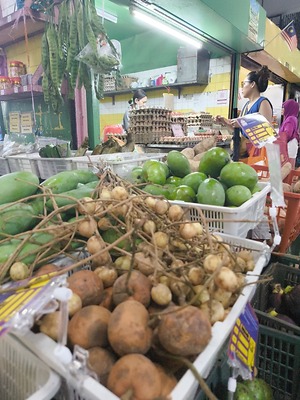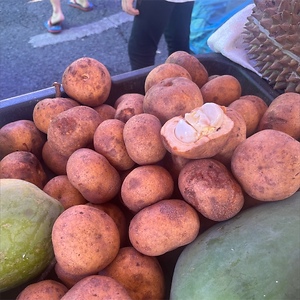


Tampoi Fruit
Estimated Inventory, lb : 0
Description/Taste
Tampoi grow on long, green stems directly from the trunks and branches of the tree. The fruits are 5 to 7 centimeters around and flattened at both ends, with smooth-textured, brownish-orange skins. Beneath the skin lies a thick pith and a hollow cavity containing succulent white or translucent, segmented flesh. Each removable segment contains a large, brown, inedible seed. Tampoi are juicy and have a slightly earthy, sweet-sour flavor.
Seasons/Availability
Tampoi fruits are available in year-round with a peak season in the winter and early spring months.
Current Facts
Tampoi fruit, also known as Lara or Kapul, are botanically known as Baccaurea macrocarpa. Buah Tampoi, in Malaysian, has flesh that resembles a mangosteen but it is unrelated and part of the Phyllanthaceae family. Tampoi is also used to describe other thick-fleshed fruits of the Baccaurea genus. They are closely related to the liposu and rambai, which has an edible skin.
Nutritional Value
Tampoi fruit are a good source of beneficial phenols and flavonoids and contain carotenoids. The flesh provides high levels of antioxidants.
Applications
Tampoi fruits are eaten fresh, each segment eaten raw and the seed expelled. To open the outer shell, pierce the top with the thumbs or score around the center with a sharp knife. Twist the two halves apart to reveal the white fleshed segments inside. Remove the flesh from the pod and separate the segments. The flesh can be added to stews, pickled or fermented to make wine. Store unopened Tampoi at room temperature for up to a week. Flesh can be refrigerated for a few days.
Ethnic/Cultural Info
Until recently, Tampoi could only be found in the wild or in home gardens. Farmers in the state of Sarawak on Borneo have taken to domesticating and cultivating Tampoi in an orchard-type setting due to the popularity and demand for the fruit. Farmers in the Malaysian states of Kelantan and Pahang on the Malaysian peninsula are also cultivating the tropical fruit. In 2009, the Malaysian Agricultural Research and Development Institute (MARDI) made an argument for domestication of Tampoi for not just economic gains but also as an effort to protect the species from extinction.
Geography/History
Tampoi are native to the island of Borneo and have a natural range that covers peninsular Malaysia, Singapore, Sumatra, and Java. There are at least 50 different species in the Baccaurea genus, all of which are native to the same area. Tampoi are the most cultivated and most popular species in the genus. The hard-shelled fruits are particularly popular with the Iban people of Sarawak and Semelai of Pahang in Malaysia, who use the fruits to make wine for their celebrations. Tampoi can be found in markets throughout Borneo, Sumatra, Java and Malaysia.
Recipe Ideas
Recipes that include Tampoi Fruit. One
| YouTube |
|
Tampoi |









